White-rumped Munia (Lonchura striata)
| White-rumped Munia Lonchura striata | |
|---|---|
| Name | White-rumped Munia |
| Name Lat. | Lonchura striata |
| Family | Estrildid Finches |
| Family lat. | Estrildidae |
| Order | Perching Birds |
| Order lat. | Passeriformes |
| Origin | Southeast Asia |
| Climate | Tropical |
| Diet | Finch seed, sprouts, herbage, insects |
| Keeping | Pair, group |
| Care Level | Easy |
| Reproduction | Finch nest |
| Life Span | 5-10 years |
| Protection | No |
| Metric Units | |
| Size | 12 cm |
| Temperature | Room temperature |
| Housing | 80 x 40 x 40 cm |
| US Units | |
| Size | 4.7" |
| Temperature | Room temperature |
| Housing | 30" x 15" x 15" |
Distribution and habitat
The home of the pointed-tailed bronze male wild form is large parts of South and Southeast Asia, where they are common in forest and field margins with dense bushes. Today they are only offered as a breeding form.
Cage size
The minimum cage size is 80 x 40 x 60 cm (L x W x H) for 2-4 animals. The cage must be placed in a bright, draught-free and quiet place at a height of at least 80 cm (except aviaries), have a rectangular base and be opaque on three sides, aviaries on one side. Keeping in an indoor aviary (e.g. 150 x 70 x 150 cm) is preferable. Birds kept in a cage should be allowed daily controlled free flight indoors without danger after a period of acclimatization.
Maintenance
The floor must be covered with sand, wood granulate, bark mulch or similar material and must be cleaned regularly. At least 3 perches made of wood or branches of different thickness and height must be installed in such a way that they can only be reached by flying and that the longest possible flight distance is created. They need a bathing opportunity as well as biotope-like hiding, sleeping and nesting possibilities. It is recommended to provide them with grasses, twigs and bushes. They should be kept at room temperature, between 18 and 25 °C.
Diet
The species-specific food supply consists of mixed seeds, available in specialized trade as "exotic food" in premium quality, supplemented with foxtail millet, tangle grass seeds, green food (chickweed, green panicle millet, fresh grass panicles, cucumber slices etc.), germinated seeds (millet, oats, wheat) and especially for rearing young additionally egg food as well as in small quantities insect larvae (buffalo worms, ant pupae, pinkies). Charcoal, vitamine lime and shell grit are needed as digestive aids. Drinking water must always be available in birdbaths or in stable, open containers. Food and water must be offered fresh daily, and the containers must be cleaned beforehand.
A regular and varied diet promotes health and prevents deficiency symptoms.
Reproduction and breeding
Both sexes are equally colored, the female has a slightly rounder head shape. A clear distinguishing feature is the song of the male.
They like to breed in biotope-like facilities such as wicker nests (bionesters) and half-open nest boxes of medium size, or freely in the branches (e.g. broom, bamboo, reeds etc). Coconut fibers, sisal and longer grasses serve as nesting material. The clutch consists of 3 to 6 eggs, the incubation period is about 14 days. The breeding season, biologically, is often in the spring and summer months. When breeding, the room temperature should be at least 18 ° C.
Important
They must not be kept in a round cage. An aviary is required for keeping a group (flock)
When kept in an outdoor aviary with a height of at least 1.70 m, they also need a heated shelter with a floor area of at least 1 m², which can be visited by the birds at any time. The temperature in the shelter must not fall below 10 °C and the furnishings must correspond to those of cage keeping.
They may only be kept in pairs or in a group or flock. Socialization with other finches is possible
In rooms, including shelters, sufficient daylight or flicker-free artificial light (stroboscopic effect) corresponding to daylight must be provided. The lighting duration shall be 8-14 hours per day and the natural day-night rhythm shall be observed. Adequate indoor climate shall be provided. The health condition of the birds shall be checked daily
Further literature can be found in your pet store.
References
Text: Othmar Sieberer; Image: Franz Lowak
Source: BMEL (1995): Tierschutzgutachten - Mindestanforderungen an die Haltung von Kleinvögeln; BMEL-Haustier-Berater.de; BIELFELD (1996): Das Prachtfinken-Buch, Verlag Eugen Ulmer; GRUMMT & STREHLOW (2009): Zootierhaltung - Tiere in menschlicher Obhut: Vögel, Verlag Harri Deutsch
- Gemäß § 21 Abs. 5 Tierschutzgesetz idgF
